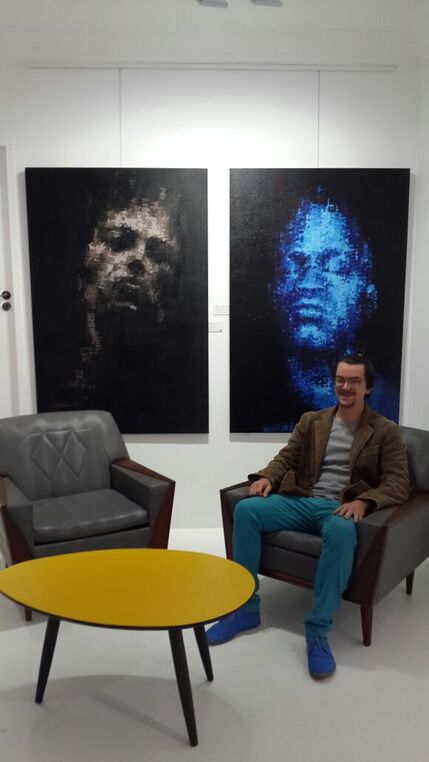BINARY TRANSCENDENCE
WORLDART GALLERY
SOLO EXHIBITION
OCTOBER 2015
SOLO EXHIBITION
OCTOBER 2015
In a world increasingly defined by social and online media, the digital has become ubiquitous. At its core, all internet information and imagery is nothing more than a series of 1's and 0's - binary code. We have the power to transform this digital information into a vast array of visual representations. Yet, these representations are not tangible; they exist only in the realm of the imagination. As a result, the boundaries between the physical and digital worlds have become increasingly blurred, creating endless possibilities for transformation and self-reinvention.
My body of work explores these themes by "hacking" the traditional portrait. As a "Portrait Hacker," I use a process that modernizes the portrait by etching it mechanically into text. I create a stamp using foam letter cutouts, assembling a name or word that is connected to my subject. Through a continuous process of stamping and layering the print, the image slowly emerges - transformed into a coded and industrialized web of paint.
While the process may seem mechanical, the formation of the image is organic, with the stamps forming the portrait in unpredictable ways. By eliminating the conventional process of paintbrush to canvas, I create a digitized rendition that re-invents the subject. My work challenges traditional notions of portraiture, transforming the way we think about representation and identity in the digital age.
‘Looking at Chandler's work I realise that we are not really speaking about portraits, but about paint as a kind of sonar – a strangely legible yet abstract rendering of a being's affect […] It is here that Chandler plays his part in this story, for in his ability to capture energy, momentarily stabilise the unstable, and gift us with character as something active, something molecular, Chandler also promises to rethink what matters; what makes us human. ‘
-Ashraf Jamal
(The Journey of One Man,
25 November 2014)
My body of work explores these themes by "hacking" the traditional portrait. As a "Portrait Hacker," I use a process that modernizes the portrait by etching it mechanically into text. I create a stamp using foam letter cutouts, assembling a name or word that is connected to my subject. Through a continuous process of stamping and layering the print, the image slowly emerges - transformed into a coded and industrialized web of paint.
While the process may seem mechanical, the formation of the image is organic, with the stamps forming the portrait in unpredictable ways. By eliminating the conventional process of paintbrush to canvas, I create a digitized rendition that re-invents the subject. My work challenges traditional notions of portraiture, transforming the way we think about representation and identity in the digital age.
‘Looking at Chandler's work I realise that we are not really speaking about portraits, but about paint as a kind of sonar – a strangely legible yet abstract rendering of a being's affect […] It is here that Chandler plays his part in this story, for in his ability to capture energy, momentarily stabilise the unstable, and gift us with character as something active, something molecular, Chandler also promises to rethink what matters; what makes us human. ‘
-Ashraf Jamal
(The Journey of One Man,
25 November 2014)
